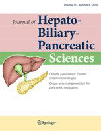Pancreatobiliary reflux and the length of a common channel
Abstract
Background/purpose
Gallbladder cancer occurs frequently in patients with pancreaticobiliary maljunction due to pancreatobiliary reflux. Pancreatobiliary reflux is also detected in some patients with a relatively long common channel. This study aimed to clarify the correlation between pancreatobiliary reflux and the length of a common channel.
Methods
Two hundred and three patients, in whom both the length of a common channel and amylase level in the bile were measured, were enrolled from nine centers.
Results
Bile amylase level was correlated with the length of a common channel (p < 0.01). The minimum length of a common channel that could induce a markedly elevated amylase level in the bile (>1,000 mg/dl) was determined as 5 mm. We redefined high confluence of pancreatobiliary ducts (HCPBD) as cases with a common channel ≥5 mm, in which the communication between the pancreatic and bile ducts was occluded with the sphincter contraction. Gallbladder cancer was found in 20% of 56 redefined HCPBD patients. Bile amylase level >1,000 mg/dl and biliopancreatic reflux were detected in 79 and 95% of the patients, respectively.
Conclusions
Patients with a common channel ≥5 mm (redefined HCPBD) should be monitored for the development of gallbladder cancer, as they frequently showed significant pancreatobiliary reflux.




